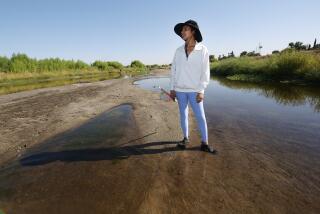State Says Fish Kill May Have Been Higher
SACRAMENTO — The massive 2002 Klamath River fish kill, already counted as one of the nation’s largest, could have killed twice as many fish as previously projected, the state Department of Fish and Game said Friday.
Commercial fishermen said the larger projected kill could do even more harm to their industry next year, as the offspring of that fall’s salmon run begin to return upstream from the ocean. They complained that conditions this year could spark a repeat of the disaster.
“Maybe as much as half the run died in one fell swoop,” said Steve Pedery of the Oregon Natural Resources Council.
The federal Bureau of Reclamation said it is prepared to release more water as needed this summer to avert another fish kill, and questioned the new, higher kill estimate.
The previous fish-kill estimate of 34,056 fish was “conservative,” the Fish and Game department said in its final report on the incident. “Actual losses may have been more than double that number.”
“We’re two years later. How do we know that?” said Jeff McCracken, a spokesman for the Bureau of Reclamation.
The state report blamed a near-record low river flow for concentrating returning fall-run Chinook salmon near the mouth of the river, where they were susceptible to bacterial infections. The conclusion was similar to that previously reached by the U.S. Fish and Wildlife Service and the Yurok tribe.
The result was “unprecedented” for the Klamath River and perhaps the largest salmon kill ever recorded on the West Coast, said report coauthor Steve Turek, a senior state environmental scientist.
Like other major kills on Oregon’s Rogue River, California’s Butte Creek, and British Columbia’s Babine and Frasier rivers, the fatal combination seems to be lots of fish, not enough water, warm water temperatures and the presence of disease, the Fish and Game department found.
Ironically, the fall run was larger than average that year, helping lead to the die-off that now threatens fishermen’s limits. “Not many fish are coming back. Now we know why,” said Glen Spain, regional director of the Pacific Coast Federation of Fishermen’s Assns.
That will mean record low salmon runs next year and devastating losses for commercial fishermen up and down the West Coast, Spain said. His organization earlier this month asked President Bush for economic disaster relief for losses it said could run to hundreds of millions of dollars for fishing communities from Fort Bragg, Calif., north to Coos Bay, Ore.
Spain contends that the federal government is creating the same conditions this year by releasing too little and too warm water from the Klamath Basin, leading to “a perpetual drought on the lower river” to save irrigation water for farmers upstream.
But McCracken said the government released sufficient water from the tributary Trinity River last year to avoid another Klamath fish kill, and is prepared to do the same this year if necessary. A pending federal court agreement on Trinity water levels “will provide a lot of fresh, clean water in the years ahead, which is going to resolve a lot of the issues,” he said.
More to Read
Sign up for Essential California
The most important California stories and recommendations in your inbox every morning.
You may occasionally receive promotional content from the Los Angeles Times.










